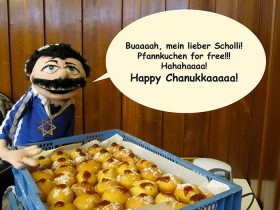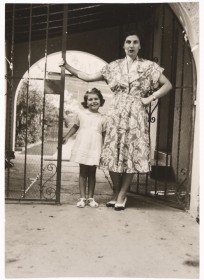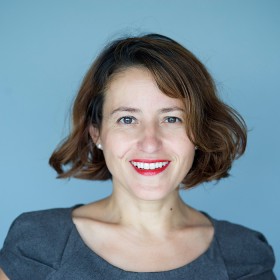
One of the hand puppets from Shlomit Tulgan’s bubales family saying “Oooh, my oh my! Hotcakes for free!!!”
CC-BY Shlomit Tulgan
I was asked recently if I could write something about how I celebrate Hanukkah in my own circle of family and friends. It occurred to me that the last time I spent Hanukkah with friends or with my parents was quite awhile back. I rummaged around through old photos until I found a picture of me with my father in 1988, lighting our Hanukkah candelabrum: we had just applied for political asylum in West Berlin and were allowed to stay with friends, so we didn’t have to remain longer in refugee quarters. For me back then, Hanukkah was a personal, family thing. → continue reading
A Look at the Radzewski Family Photo Collection
We all have family: father, mother, children, grandchildren, grandparents, aunts, uncles, or just relatives casually come across at family reunions or known from photos. “The uncle, living abroad, with the daughter and the grandchildren – don’t you remember him?” We’ve all heard that.

The donor, Vera de Jong with her mother, Meta Krotoschiner in front of their home in Santiago, Chile, in 1952, following immigration © Jewish Museum Berlin, gift of Vera de Jong, née Krotoschiner-Radzewski
What happens when there’s no one to keep telling these stories? Only a photo of these people remain, if you’re lucky, sometimes a postcard that says nothing. This isn’t only the case in our private lives. As museum workers, we confront this challenge on a daily basis, especially when inventorying collections of donors’ family photographs. Each photo poses the same questions: Where was this? Who were these people – friends or relatives? What’s the story behind the image?
Fortunately we have help. Along with the photographs, donors provide and entrust us with their memories. Vera de Jong, born Krotoschiner-Radzewski, is one such example. Last year she gave our museum some 200 family photos (further information about the Photographic Collection on our website). As an academic trainee, it was then my task to inventory this collection and research its history. I was immediately taken by these charming images and, while researching them, understood their historical value, helping us uncover more than a century of family history. → continue reading
The “Daughters and Sons of Gastarbeiters” (guest workers) are the Academy of the Jewish Museum Berlin’s guest on 14 October 2015, part of the “New German Stories” series. As children, these Berlin authors followed their parents to Germany from their home villages in Anatolia, southern Europe and the Balkans, or they were born into working-class neighborhoods around Germany. Their mothers and fathers were supposed to bolster the German economic recovery as mere “guest workers”. The authors tell their personal stories, look back, follow their parents’ paths and thus add to Germany’s culture of memory. In advance of the event, we’ve asked three questions of Çiçek Bacık, the project’s leader and co-initiator:

Çiçek Bacık © Neda Navaee
Ms. Bacık, how did the “Daughters and Sons of Gastarbeiters” come to be and what was the motivation to tell these personal stories?
Last year, I went to a reading with my friend, the journalist Ferda Ataman. We were sitting in a bar afterwards. “Ferda, we have to start telling our stories and share them with others. We ourselves have to shed light on a dark chapter of our past we’ve successfully repressed,” I said. “Sure, and what’s stopping us?” That was the starting point for “Daughters and Sons of Gastarbeiters”. Our first reading took place in January 2015 at the Wasserturm in Kreuzberg. → continue reading


